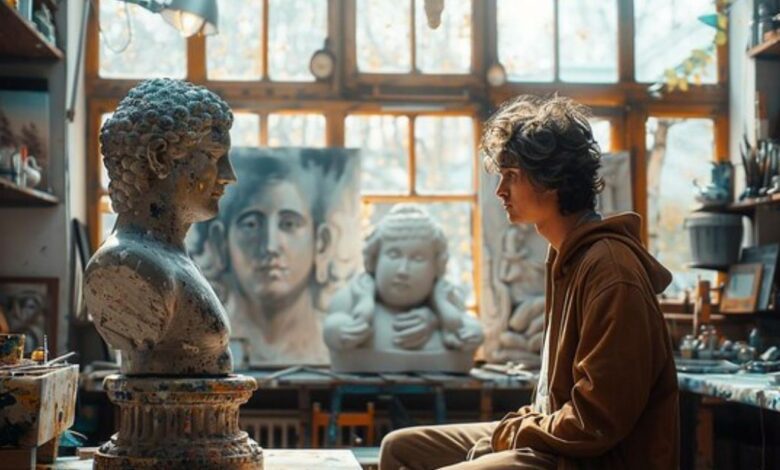Ancient Artz: Exploring the Timeless Wonders of Creativity

When we speak of ancient artz, we delve into the origins of human creativity and expression. These art forms are windows to the past, offering insights into the lives, beliefs, and values of ancient civilizations. From paintings on cave walls to elaborate sculptures and intricate pottery, ancient artz showcases the timelessness of human creativity.
The Origins of Ancient Artz
The roots of ancient artz date back thousands of years, to a time when early humans began expressing themselves through rudimentary yet deeply meaningful art forms. The earliest examples are often found in cave paintings, which capture scenes of hunting, rituals, and daily life. These initial steps toward artistic expression reveal a connection between humans and their environment, emphasizing storytelling and preservation of knowledge.
Ancient Egyptian Art: The Art of Eternity
One of the most remarkable and well-preserved examples of ancient artz is found in Egypt. The art of this civilization emphasized eternity, power, and divinity. Wall paintings, massive pyramids, and sculptures depicted gods, pharaohs, and everyday life in a stylized manner. Egyptian art had a strict set of rules and conventions, reflecting the society’s strong belief in the afterlife. The Great Sphinx and the statues of Ramses II are just a few of the many creations that continue to leave a profound impact on visitors today.
Mesopotamian Art: A Reflection of Power and Spirituality
Ancient Mesopotamia, known as the cradle of civilization, contributed significantly to ancient artz. Their art focused on power and the divine, often portraying kings, gods, and mythological creatures. Ziggurats, or massive stepped temples, and relief sculptures are notable examples of Mesopotamian art. This style not only represented religious and political ideals but also aimed to immortalize the achievements of rulers.
The Mystical World of Ancient Greek Art
Ancient Greek art, often hailed as the birthplace of Western aesthetics, introduced realism and human-centered themes into its creations. Greek sculptures, such as those depicting gods like Zeus and Aphrodite, aimed to capture the ideal form and beauty of the human body. Their pottery, adorned with scenes from mythology and everyday life, revealed a culture fascinated by heroism, drama, and perfection. Greek art’s influence remains evident in modern Western art and architecture.
Roman Art: Innovation and Adaptation
Following the Greeks, the Romans expanded on the themes of realism and narrative in their art. Roman art, which is part of ancient artz, combined influences from Greek, Etruscan, and native Roman traditions. The Romans introduced new techniques in sculpture and painting, emphasizing realism and detail. Their architectural achievements, such as the Colosseum and aqueducts, demonstrate the artistic and engineering prowess of the civilization. Roman mosaics and frescoes continue to captivate with their detailed storytelling and vibrant colors.
The Spiritual Art of Ancient India
In ancient India, art was deeply intertwined with spirituality. The artistic traditions were reflective of religious beliefs, particularly Buddhism and Hinduism. Temples, sculptures, and cave paintings illustrated deities, spiritual teachings, and the journey towards enlightenment. The Ajanta and Ellora caves are perfect examples of how ancient art’z in India were dedicated to spiritual exploration and reverence for nature. Intricate carvings and mural paintings offer a glimpse into the devotion and skills of ancient Indian artists.
Chinese Art: Tradition and Symbolism
The ancient artz of China is distinguished by its rich symbolism and tradition. From the delicate brushstrokes of calligraphy to the elegance of jade carvings, Chinese art reflected the philosophies of Confucianism, Taoism, and Buddhism. The Terracotta Army, commissioned by Emperor Qin Shi Huang, remains a fascinating example of Chinese artistry and military culture. Ancient Chinese art emphasized balance, harmony, and respect for nature and ancestors.
The Art of the Americas: A Window to Ancient Cultures
The ancient civilizations of the Americas, such as the Maya, Aztec, and Inca, created artworks that celebrated their beliefs and social structures. These civilizations expressed their ideas through monumental architecture, ceramics, and textiles. For example, the intricate designs of Mayan stelae and the stunning Incan textiles showcased not only their artistic skills but also their complex social and religious structures. The ancient art’z of the Americas provided a means of connecting with their gods and commemorating their histories.
African Art: A Blend of Ritual and Reality
Ancient African artz reveals a deep connection between art, community, and spirituality. African art often served as a medium to communicate with the spiritual world, celebrate communal rituals, and honor ancestors. Masks, sculptures, and textiles were not only visually captivating but also carried symbolic meanings. The Great Zimbabwe and the terracotta sculptures of the Nok culture are among Africa’s ancient artistic treasures, showing a diverse and vibrant cultural heritage.
Indigenous Australian Art: Stories on Rock and Sand
In Australia, the indigenous communities created art that conveyed their deep connection to the land and their ancestors. Ancient art’z in Australia includes rock paintings and engravings, which often depicted Dreamtime stories—mythological tales explaining the origins of the world. These artistic expressions served as a form of storytelling, passing down knowledge and cultural beliefs from generation to generation.
The Universality of Ancient Artz
Despite the differences in style, technique, and medium, ancient art’z across the globe shares common themes: spirituality, community, and the human experience. Whether through the grandeur of the Egyptian pyramids or the intricacy of Greek pottery, ancient art’z reveals the universal desire to explore identity, existence, and the mysteries of the universe. These works tell stories of human resilience, beliefs, and aspirations that transcend time and place.
The Evolution of Techniques in Ancient Artz
One of the most fascinating aspects of ancient artz is the evolution of artistic techniques. From the simplistic lines of early cave paintings to the sophisticated marble sculptures of the Greeks, ancient artists continually sought new ways to express their creativity. Innovations such as the introduction of perspective in painting, metal casting in sculpture, and the development of natural dyes revolutionized artistic expression.
The Impact of Ancient Artz on Modern Art
The influence of ancient artz can be seen in various aspects of modern art and design. Contemporary artists often draw inspiration from ancient themes, techniques, and symbols. The motifs from Egyptian art, the realism of Greek sculptures, and the narrative style of Roman art continue to shape modern creative expressions. The legacy of ancient artz is a testament to the enduring power of human creativity and its ability to inspire future generations.
Preserving the Legacy of Ancient Artz
As time passes, the preservation of ancient artz becomes increasingly crucial. Governments, historians, and artists work tirelessly to protect and restore ancient artworks, ensuring that these cultural treasures remain accessible to future generations. Through advanced technologies like 3D scanning and digital archiving, we can document and preserve the essence of ancient artz for the coming centuries.
Conclusion
Ancient artz holds a mirror to the past, reflecting the diverse cultures, beliefs, and stories that shaped human civilization. By exploring these timeless creations, we gain a deeper understanding of our shared heritage and the enduring spirit of creativity. The art of ancient civilizations continues to inspire awe, provoke thought, and connect us to those who came before us.
FAQs
What is the significance of ancient artz?
Ancient artz is significant as it offers insights into the beliefs, values, and daily lives of ancient civilizations. It also showcases the evolution of human creativity and techniques over time.
How did ancient artists express their beliefs through art?
Ancient artists expressed their beliefs by depicting gods, rituals, and spiritual themes. Their art served as a medium to honor deities, commemorate rulers, and convey cultural values.
What are some well-known examples of ancient artz?
Well-known examples include Egyptian pyramids, Greek sculptures like the Parthenon Marbles, and the Terracotta Army in China. Each of these works reflects the artistic achievements and cultural significance of its civilization.
How does ancient artz influence modern art?
Ancient artz influences modern art through its themes, styles, and techniques. Many contemporary artists draw inspiration from ancient motifs, storytelling methods, and sculptural styles.
What are some challenges in preserving ancient artz?
Preserving ancient artz involves challenges such as environmental damage, human negligence, and theft. Technological advancements like 3D scanning and digital preservation help mitigate these challenges.



